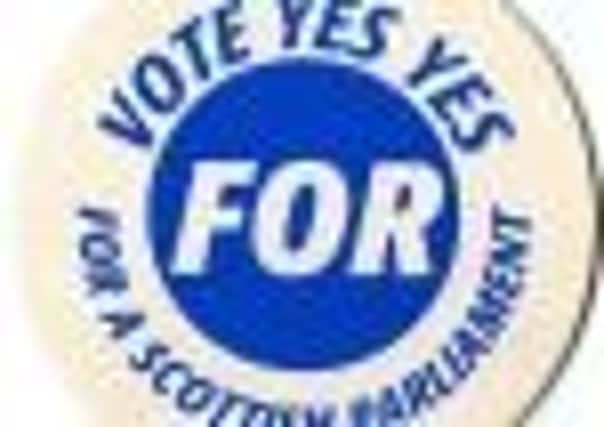How the ghost of referendums past fascinates us today


As Scotland gears up for a referendum in 2014, with the possibility of “devo-max” as well as independence and the status quo appearing on the ballot, an exhibition opened yesterday on the referendums of 1979, and 1997, when devolution first failed, and then succeeded, at the ballot box.
Democracy for Scotland: the Referendum Experience, at the Museum of Edinburgh, features everything from the periods, from campaign buttons and T-shirts, to recorded interviews with key players and even a bottle of Referendum Whisky.
Advertisement
Hide AdIt includes memorabilia from the famous five-year vigil in a hut on Calton Hill staged by Democracy for Scotland campaigners, including a painted shield celebrating the Flame of Democracy and a quaich for a shared dram.


A mock ballot box in the corner invites visitors to cast practice votes.
Key themes in the exhibition included how the Labour Party split in 1979, with influential figures like Tam Dalyell joining the ‘Labour Votes No’ campaign. The exhibition occupies just one room at the museum, but its opening yesterday brought a noisy gathering of veteran campaigners, like former civil servant Gillian Grant, a regular visitor to the Calton Hill vigil that began in 1992.
She said it began out of a “real feeling of helplessness” after the 1979 referendum was lost.
Devolution, under the Scotland Act, won a majority of votes cast, but just failed to reach the 40 per cent of the total electorate demanded in an amendment to the measure put through by Labour backbencher George Cunningham.
The numbers board from the hut, used to count the days, is on display, along with a banner.
“We used to do a night shift,” Ms Grant said.
Advertisement
Hide Ad“Whoever was on the shift in the morning, they would come down and change the number of the vigil day. When it started it was an A4 piece of paper, and someone wrote one on it,” she said.
On the wall – in one echo of the current debate – is a Scottish National Party leaflet from its North Sea oil campaign of the mid 1970s, declaring: ‘Scotland’s Oil - It’s London’s Rip-Off! The Norwegians and the Arabs wouldn’t stand for it. Why should we?’
Advertisement
Hide AdOne notice from the ‘Think Twice’ campaign urging people to vote ‘No No’ in 1997 warned that the cost of devolution would be “£350 per working person”.
The Referendum Whisky was produced by the pro-devolution group Scotland FORward, and is labeled ‘Say ‘Aye’, quoting Robert Burns: “Freedom and Whisky gang-the-gither.”
Museum staff collected materials during the campaigns, including photographs of marches down Princes Street.
Isobel Lindsay, convener of the Campaign for a Scottish Parliament, which was active in both referendums, said: “It’s interesting. One of the things I would guess people will be doing is looking back at the ‘no’ material both in 1979 and in 1997, to see the arguments. They tried to use all these scare stories, that business will leave Scotland.”
Scottish lingerie tycoon Michelle Mone has threatened to move to England if Scotland votes for independence.
“There was the Michelle Mone syndrome then as well,” said veteran campaigner Douglas Robertson.
Advertisement
Hide Ad“Nothing really changes. You will find the same arguments, the same discussions.”
One focus of the exhibition is the divisions that emerged within the Labour Party. “It was awful, because there was no coordination of the campaign,” Mr Robertson said.
Advertisement
Hide AdThe exhibition draws on the collections of the Scottish Political Archive at Stirling University, with more information available at the archive’s website at scottispoliticalarchive.org.uk
1997 SUCCESS
In 1997, the Labour Party included the establishment of a Scottish Parliament in its manifesto for the United Kingdom general election.
In the referendum that followed, 74.3 per cent of voters agreed that there should be a Scottish Parliament, and 63.5 per cent said it should have tax-varying powers.
Overall turn-out was 60.4 percent.
“The 1979 referendum was a textbook case of how not to run a campaign in a referendum,” said Nigel Smith, chairman of the Scotland FORward campaign.
“And that was really my starting-point. We were not going to make that mistake.”
Helen Scott, of the Conservatives, added: “It was a very difficult period for us after the ’97 election – there was a huge surge of enthusiasm for New Labour, and they were promoting it, so I think that meant it was unlikely that we were going to win.”
1979 DISASTER
Advertisement
Hide AdOn 1 March, 1979, Scotland voted on the Scotland Act, the devolution bill put through by the Labour UK Government after pressure from the SNP.An amendment by Labour backbencher George Cunningham required a “yes’” vote by at least 40 per cent of the eligible electorate.
The vote was 52 to 48 per cent in favour, but only 32.9 per cent of the electorate backed devolution.
Advertisement
Hide Ad“There was so much scepticism within the party about it, that it was as far as we could go,” George Foulkes, then a Labour MP, said in interviews recorded for the exhibition.
“In today’s context it would not seem revolutionary, but at the time it seemed pretty revolutionary.”
“It came about far too early for the SNP, although you were campaigning for independence, here a devolution bill had arrived. Nobody really understood what it meant,” admitted Jim Thomson of the SNP.